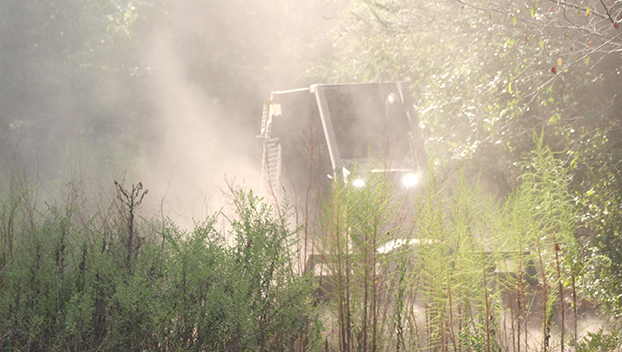Fire work continues in summer
Published 1:00 pm Sunday, July 21, 2024

- A dozer cuts a fire lane through a haze of smoke while fighting a wildfire in Lincoln County in September 2023. Dozers are one tool used by Mississippi Forestry Commission fire fighters and US Forest Service Firefighters to contain wildfires. (Hunter Cloud | The Daily Leader)
BUDE — Conditions from late June to September are usually not conducive to prescribed fires. Temperatures are hot, humidity is often high, fuel is green and low winds make it hard for fire to carry.
Homochitto National Forest Fire Management Officer Trey Bolt said they spend the dog days of summer carrying out other work. Sometimes, the fire protection team is called out west to help fight fires in California, New Mexico, Arizona, Oregon and Washington. Oftentimes, they help with responses in Texas and Louisiana.
“Right now we are trying to fit in training sessions. We did a week- long saw course last week,” Bolt said. “We support the western fire season when it heats up. We go out and support where needed. Our engines and helicopter crews are sent wherever they need to send us.”
If they are at home in the Homochitto National Forest then they begin working on the next year’s plan for burns. Prep work with brush hogging takes place later on in the summer. Crews will be out cutting down dead pine trees lost to the drought and beetle infestation.
“The more we cut down now the less we will have to deal with,” Bolt said.
Post burn inspections
Summer is also a good time to conduct post burn inspections on blocks. In fact, the fuels technician for National Forests in Mississippi was in Bude last week looking at plots in the units. Data is recorded on the quality of vegetation and species composition in those post burn inspection plots.
Post burns follow up a year later and two years later. Bolt said they burn frequently enough on the Homochitto National Forest to not have inspections for the past two years. The data collected is a critical part of the burning regime as it measures how successful the fires are at creating the desired habitat and reducing fuel load.
The national forest is starting to dive into using lidar scans to survey vegetative responses to burning and fuel loads.
“It will be the way we measure fuel load in the future,” Bolt said. “We are starting to get into the scanning.”
Wildland fire
Last year was a different year for Southwest Mississippi. Typically, the Mississippi fire season is from October to April but a drought caused wildfire conditions to pick up in August. Bolt said last July they noticed it was starting to get dry, fuel moisture conditions are better this year at this point.
It was a wildfire season unlike any other. Bolt started his career with the forest service in May 2002. He started as a student working in the forest on an internship. Bolt said he went to marine mechanic school after high school but when Lake Okhissa hit a hiccup in opening he went to work for the Forest Service again.
“I got into full time fire then and have been in it ever since,” Bolt said. “I’ve always been in fire with the forest service. You never do the same thing twice in a row. It is the same but different, always something different.”
Last year was a great year for the crew to stay on its toes especially with a younger and new crew. Bolt said the fire shop was stable for years but several guys retired. Drought conditions and the new guys coming in set up a season prime for potentially catastrophic wildfires.
“We had significant fires and some could have been worse,” Bolt said. “We don’t just work in the forest. We work with the Mississippi Forestry Commission because we rely on each other quite a bit. We had some resources come in from out west. We probably responded to 50 plus fires larger than our normal average wildfire size. Last year was a different year.”
Bolt said the biggest wildfire on the forest was 400 acres. Outlooks for this year are not as bleak as they were last year.
Southwest Mississippi is a landscape historically shaped by lightning strike fires. The difference between wildfires in Mississippi and other parts of the country is the amount of green fuel present.
With the exception of last year, Bolt said most years there is a small time frame where low humidity and winds are suitable for wildfires to spread. Thankfully, most homes in the south have some sort of yard with green grass which either doesn’t burn or slows down the fire.
“Maintaining defensible space is the biggest thing you can do around your house,” Bolt said. “Keep your yard maintained, brush trimmed and space around the house cleaned up. All of it adds up to take away the fuel the fire has to burn.”
Last year, wildfires would be contained and then a week later the heavy fuels would catch fire again or pine needles would drop causing the fire to pick up again. Bolt said one wildfire burned seven times in an area.
Prescribed fire helps lower the intensity of wildfires and the established firebreaks in blocks helps in the work to contain fires.




